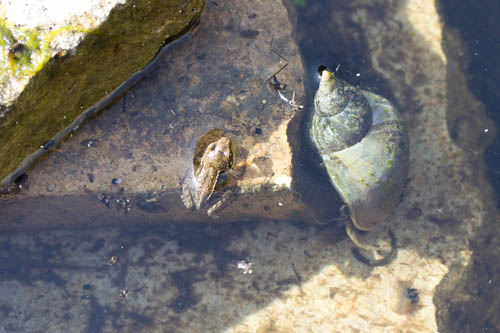
Large Red Damselfly, just emerged – you can see the empty pupal case to the left.
Walking past the pond a day or two ago, I noticed the flash of shiny wings and thought it was a crane fly, or similar, as I’d seen one a few days previously. Carrying on across the garden, I saw a flying insect land on an allium leaf, and on closer inspection, it was a damselfly. This made me wonder if it was actually a damselfly I’d seen over the pond, and whether we might have some emerging.
We regulary see dragonfly/damselfly larvae in the pond – they often catch your eye because they move so quickly, though in doing so, they’ve probably shot out of sight. A good way of seeing them is to go out with a torch at night, when they will often be visible and quite still on the side of the pond. We used to have Southern Hawkers emerging from the pond quite regularly at the end of May; we didn’t get any last year, but the experience has taught us where to look for the emerging larvae.

Large Red Damselfly
I grabbed the binoculars and headed back to the pond. Sure enough, on looking towards the bottom of the many reeds starting to grow out of the water, I soon spotted a small larval case – then another, then another. By the time my husband and I had been staring at the reeds for a while, we were up to at least 10, and no doubt there were more we didn’t see.
One adult damselfly, as we watched, flew up and landed on some leaves at the side of the pond – shown in the photo above. He/she sat there for some time, then took off and flew towards the hedge, wings glinting brightly in the sun, only for a bird to fly out and grab it. It seemed a rather sad end, after all that growing as a larva, then surviving the actual emergence, but the bird needed to feed its young, so that’s the way it goes.
We live in hope of Southern Hawkers emerging again this year, as we know a female laid in and around the pond last September, but the larvae sometimes stay in the pond for two years, so there are no guarantees. The photo below was taken on 1 September 2012, and you can see she is bending the back half of her body round, to lay her eggs; she not only laid them around the edges of the pond itself, but also in a couple of logs we keep to each end of the pond bench as tea-cup stands. It definitely shows that having natural wood around the garden is wildlife friendly, just as the experts say.

Female Southern Hawker dragonfly laying eggs at the edge of the pond






